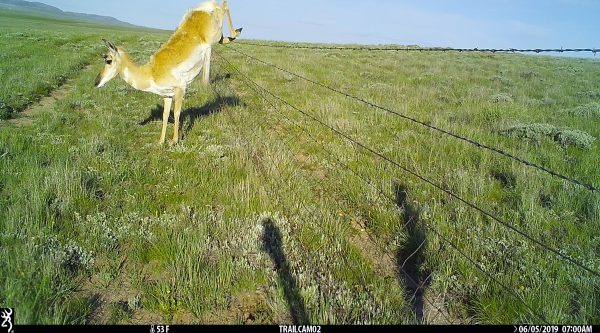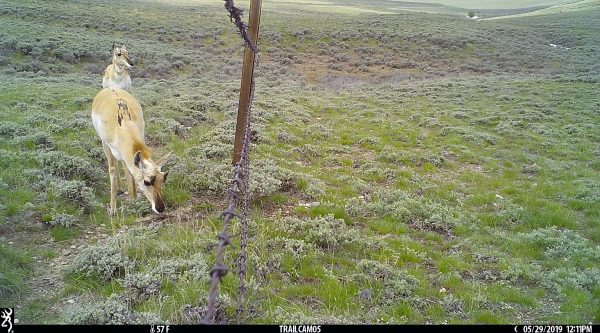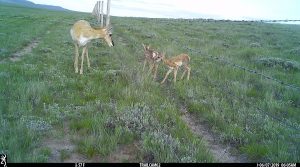Many pronghorn antelope of the western states migrate similar to the mule deer and elk. However, due to their anatomy structure, the task as a whole is much more difficult than that of an elk or a deer. Pronghorn antelope are built for speed, not jumping.
A resident expert from the BioChemistry explained why and how they are built for speed. It stated: “Several features of the pronghorn antelope allow for its remarkable speed and endurance. They have lungs larger than most animals their size, a larger windpipe to inhale more oxygen. More importantly, they have a larger heart than most animals. In addition to the large heart, they have a higher concentration of hemoglobin to carry more oxygen and greater vascularization in the muscle and lung tissues.”

Sound confusing? Yep, it is. To sum it up, their body is made for the open plains. Outrunning their predators, not out jumping them.
When migrating to their winter grounds pronghorn antelope face their ultimate predator… man-made fences. Many studies have been made about pronghorn crossing fences. One such study was done by the Wildlife Society Bulletin, they stated:
“We analyzed pronghorn crossing success in Alberta, Canada, and Montana, USA, between 2012 and 2016 in response to fence‐modification treatments to understand 1) differences between bottom wire height at selected verses available fence sites, 2) the change in crossing rates before and after fence modification treatments, 3) the effect of a suite of fence, environmental, and demographic characteristics on group crossing success, and 4) the time lag until pronghorn became habituated to different fence modifications after initiation of treatments. Use of either smooth wire or clips with a bottom wire height of approximately 46 cm were most effective at allowing passage by pronghorn, while the commonly proposed goat‐bar was ineffective and created a negative behavioral response by pronghorn.
Though smooth wire and clips were effective at allowing passage, we observed a time lag as pronghorn switched use from their strong fidelity at known‐crossing sites to using modified sites. Pronghorn‐group crossing success was greatest during summer, for all‐male groups, and increased with larger group sizes. We advocate not using goat‐bars as modifications to fences, and instead, recommend using smooth wire and clips at a minimum bottom‐wire height of 46 cm to allow movement by pronghorn. Our study provides guidance for wildlife‐friendly fencing techniques to wildlife managers and private landholders as a means to improve permeability for pronghorn and additionally, can be used as a model to evaluate fence modifications for pronghorn and other target species that may be sensitive to fence interactions.”
Chances are if you hunt pronghorn in the west, you have killed a pronghorn missing large patches of hair on its back. This is due to the typical barbed wire fence that is found on most ranges in the west. For obvious reasons, this is bad for the overall health of the pronghorn, especially during the winter months.

The 3 alternatives that have been tested the most are Smooth Bottom Wire, Wire Clips and Plastic Pipe (often referred to as Goat Bar). Smooth bottom wire is just that, the bottom strand of wire is replaced with a smooth wire rather than a barbed wire. Wire clips are where the bottom 2 strands of wire are connected with a clip. This leaves a large space for the animals to cross. The Goat Bar is just a plastic tube that goes over the bottom strand of wire. Many agencies have claimed the Goat Bar is the way to go but a study done by the Alberta Conservation Association and The Nature Conservancy stated:
“They would walk up to it. They would sniff it,” Martin said. “If they were going to cross, they would never cross under the plastic. They would cross to the side of it. The idea is they were supposed to be really conducive for pronghorn to move. They actually hate them.”
Their study and many others have concluded that the smooth bottom wire was the most effective for pronghorn crossings. It is followed closely by the wire clips, which in the long run may be more cost-effective.

Many herds of Pronghorn antelope face 100+ mile migration routes twice a year. Crossing fence after fence. Anything we can do to help benefits the pronghorn and the hunters. Watch this video about the Path of the Pronghorn for more migration information
Have you ever seen pronghorn jump a fence?















